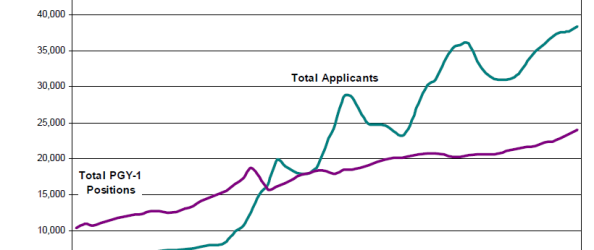
My attention was drawn to an article in the JAMA today (1) by one of my friends who is actively pursuing the USMLE route. And after reading this, I guess I have to admit that one now has to make haste in order to prevent waste. Now I have long been wanting to write about this but somehow never came around to do it. Finally, having read this article today, I decided to give it a go. Now this is entirely my perspective on last year’s match and it may be entirely off-base. So do not put too much of thought into this. This year several of my friends are appearing for the match and I wish them the very best of luck. Also, this post is intended to be a wake up call for those who have been sitting on their dates, trying to do that extra bit to eke out an exceptional score. it is time to take the plunge!
 Let us start with some number crunching first – get the boring stuff out of the way before the real horror movie starts. No, just kidding… The number of students applying for residency in the US programs has increased in leaps and bounds, as the NRMP report shows in this trend-chart dating back to 1952 (2):
Let us start with some number crunching first – get the boring stuff out of the way before the real horror movie starts. No, just kidding… The number of students applying for residency in the US programs has increased in leaps and bounds, as the NRMP report shows in this trend-chart dating back to 1952 (2):
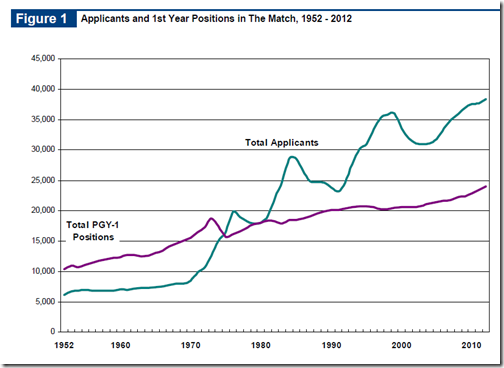
The Match system changed a bit in 1975 when the internship was retired and PGY-1 positions were offered as residency slots directly. It was also around that time, that the total number of applicants began to rival the number of positions available. Kind of makes me wonder what a paradise it is where one does not have to scramble for the seats… But let us come back to reality. In the 2012 match, a record number of PGY-1 positions were offered: 24,034, but to counter that, a record number of applicants also dropped their names into the hat: 38,377! However, this still looks like a fair competition when compared to the Indian scenario, where the approximately 7,000 residency slots are fought over by as many as 70,000 to 80,000 people – these are just anecdotal numbers generated in retrospect of my experience of “matching” in the Indian system last year but I am sure the numbers will be worse (looking from the student perspective), and not any better. I am not including the DNB or private colleges or the non-MD seats (diploma and other 2-year training courses) in this reckoning.
Coming to the non-US IMGs segment, which most of the Indian applicants belong to, let us take a look at the favored specialties which drew people:
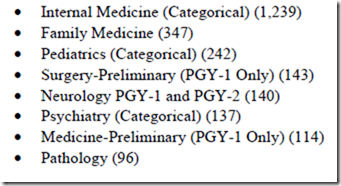
A total of 2,775 non-US IMGs were offered residency slots in the PGY-1 programs and an additional 155 for PGY-2, bringing the grand total of the matched IMGs to 2,930. Here’s the whole break up for the PGY-1 slots:
Subjects Non-US IMGs
Anesthesiology 31
Child Neurology 11
Dermatology 1
Emergency Medicine 25
Emergency Med – Family Med 0
Family Medicine 347
Family Med – Preventive Med 2
Internal Medicine (Categorical) 1239
Medicine – Dermatology 0
Medicine – Emergency Med 2
Medicine – Family Med 1
Medicine – Medical Genetics 0
Medicine – Neurology 0
Medicine – Pediatrics 14
Medicine – Prelim PGY1 only 114
Medicine – Preventive Med 0
Medicine – Primary 57
Medicine – Psychiatry 4
Neurodevelopmental Disabilities 0
Neurological Surgery 13
Neurology 67
Obstetrics-Gynecology 72
Orthoepedics 6
ENT 0
Pathology 96
Pediatrics categorical 242
Pediatrics – Anesthesiology 0
Pediatrics – Emergency Med 0
Pediatrics – Medical Genetics 2
Pediatrics – PMR 0
Pediatrics – Prelims 3
Pediatrics – primary 21
Peds/Psych/Child Psych 0
PMR 4
Plastic Surgery Integrated 0
Preventive Medicine 0
Psychiatry Categorical 137
Psychiatry – Family Med 0
Psychiatry – Neurology 0
Radiation Oncology 0
Radiology Diagnostic 11
Surgery Categorical 57
Surgery Prelim PGY1 only 143
Thoracic Surgery 0
Transitional PGY1 only 51
Vascular Surgery 2
Total 2775
Now let us take a look at the past few years for the IMGs and how they have fared:

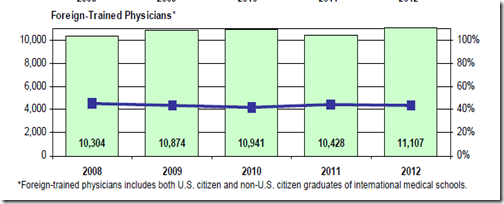
and this is in sharp contrast with the seniors of the US allopathic schools:

Or even the overall picture which is much rosier than it is for the average Indian graduate: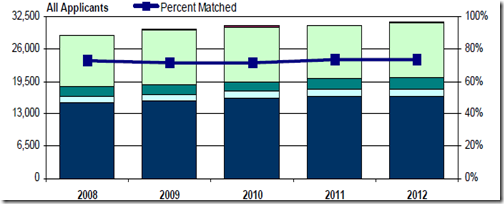
The same sentiment is shown in the trends of the match rates as well:
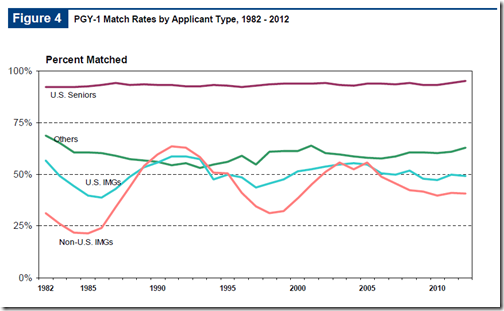
What I find interesting in this graph is the fact that while the success rates for the US Seniors has remained monotonously high (as it should be), the rates for the Non-US IMGs is dropping. With the proposed expansion of uptake of more graduate students to combat the predicted shortfall of doctors, this will get even worse, but more on that later. The other trends, namely, the US IMGs and Osteopathic and non-traditional applicants, has remained steady and shows minute upstroke of late.
Taking a look at the raw numbers confirms my fear that as more and more IMGs apply, the lesser and lesser likelier they are to match:
2003 55.7%
2004 52.4%
2005 55.6%
2006 48.9%
2007 45.5%
2008 42.4%
2009 41.6%
2010 39.8%
2011 40.9%
2012 40.6%
With these in mind let us look at what it means for people coming up ahead.
The prediction is that in 2015, the number of US-trained medical graduates will outstrip the number of residency slots up for grabs. Now that means 2015 becomes the watershed year for the IMGs, especially the non-US ones. Although some amount of the American Graduates are not going to be able to match for different reasons, that shall be the only slots available for the iMGs, since it is reasonable to believe that the system shall favor the AMGs who have come through it. And to be honest, that is exactly how it should work.
Now it would mean several things for the students overseas. It shall obviously lessen the issue of brain drain. Anecdotes go that entire batches of a certain medical college have relocated to the US post-USMLE. While that does add to the sheen of the prospects for the students of that particular institute, I believe, and bite me for saying so, it does the nation no good. Now I am not about to propose laws and rules to hold people back, nay, if anything I oppose such acts of delusional grandiosity, for people shall do what they want to, but at the same time, I believe it is a gross waste of national resources when the bulk of students from one of the best training institutes shift to the US. And take with them their expertise which could have otherwise served the nation. But that is another issue. Clearly, once the AMGs outstrip the residency slots available, the contest for seats will be vicious.
What I am wondering is that whether it shall spawn the evil of MD-love that is rampant in India. Here, at least after your MBBS, you are licensed to practice Medicine. But in the US, where the ticket to Residency is essential to make a living as a doctor, this might be a bit of a problem. A certain segment of the graduates may, after their training, move into the non-traditional routes – the pharmaceutical industry, pure research or some other forms – an option that is rapidly gaining popularity in India where MBBS graduates who are toiling for an MD-ticket get disillusioned by the unfairness of the system and jump the ship on a clinical career. It shall be interesting to see what transpires for the AMGs when the graduating students are more than the PGY1 slots offered.
The other concern is that with graduate education spending cuts coming in, the residency seats may actually shrink in the years to come. If that happens, the already decreasing number of seats shall be even more inaccessible for the IMGs. The European Union and Australasia has largely become inaccessible (the EU more so than down under, probably) to the average Indian graduate, but even with the US being cut out, the pressure on the already over-burdened PG-entrance system will become worse.
The US boasts of a rare balance of professionals of different nationalities representing its medical force. The cultural, ethnic and national diversity of the US physician corpus is probably wider than that of any other country. While that is a good thing in an age of globalization, it does not essentially mean great future for the AMGs themselves. Hence, when the AMGs outstrip the available slots, I am sure there shall be some sort of an unwritten rule to favor an AMG when one is available for a particular program, ahead of IMGs. And that is the logical thing to do as well. I mean it is senseless to burden them with $200,000 worth of student loans, decimate their social lives, often break up families, and then leave them high and dry. This would essentially mean that poorer AMGs would be selected ahead of more competent IMGs just because they were there and they applied. While the quality control and training in the US is supposed to be fool proof, yet, a compromise on quality is never good in the long run. Attend some of the peripheral government hospitals in India, and you shall know what I am talking about.
Another thing remains: the choice of specialties. The AMGs, who have an AMG:PGY1 slot ratio of 1.45 (an all time high considering the numbers from the recent past, by the way) this year, have the luxury of looking down on Primary care or Family Medicine or Pediatrics and the like – basically the specialties with the least pay, the most work and the worst of administrative handling. They are also loathe to work in the difficult areas, poorer areas, places with lesser medical services (where workload is thus higher) and the rural counties.(3) The IMGs also represent a healthy amount of the physicians in the primary care/public sector, as they twice as likely as the AMGs to take up these jobs, where they have to work longer hours, in areas which are medically underserved and hence bring them lesser money.(4) When the ratio falls below 1, and the scramble for PGY1 slots gets worse, it shall be interesting to see whether AMGs still maintain this haughty attitude towards the specialties with lesser pay and instead of waiting for a big fish settle for the smaller ones. This trend has already emerged in India where the seat crunch is severe and where the MBBS is more or less a vestigial degree. This could lead to quicker professional burn out and higher dissatisfaction, leading to poorer dissemination of services.
Rounding it off:
So what does all of this mean for you, the Indian/ International Medical Graduate? This is what I reckon, is the distilled wisdom from all this chattering:
1. Get started on those steps quickly and try for a match before 2015. Preferably for 2014, just in case something goes wrong!
2. The scores shall become important. Though they are not meant to be a screening factor, what does a Program Director do when he is faced with a deluge of international graduates with similar levels of training from a non-accredited system?
3. Being in a medical school that has premier visibility in the International community might be of help (if it is not already). We all know which Delhi and Chandigarh based medical institutes I am talking of!
4. Having a killer CV. This has always been important, but probably never more so than now.
5. Doing the rounds – the clerkships and observerships are time to build the rapport. Make the connections. Ensure that at least the Institute where you have clerked at least gives you a call up.
6. Have a plan B. Buy Mudit Khanna-Amit/Ashish or whoever is most popular in the business of giving the keys that open the doors to the Bipolar system of Indian PG selection.
References:
 1. Traverso G, & McMahon GT (2012). Residency training and international medical graduates: coming to America no more. JAMA : the journal of the American Medical Association, 308 (21), 2193-4 PMID: 23212494
1. Traverso G, & McMahon GT (2012). Residency training and international medical graduates: coming to America no more. JAMA : the journal of the American Medical Association, 308 (21), 2193-4 PMID: 23212494
2. Results and Data: 2012 Main residency match. NRMP
3. Mick SS, Lee SY, Wodchis WP. Variations in geographical distribution of foreign and domestically trained physicians in the United States: “safety nets” or “surplus exacerbation?” Soc Sci Med. 2000;50(2):185-202.
4. AMA-IMG Section Governing Council. International Medical Graduates in American Medicine: Contemporary Challenges and Opportunities. 2010. http://www.ama-assn.org/resources/doc/img/img-workforce-paper.pdf.
